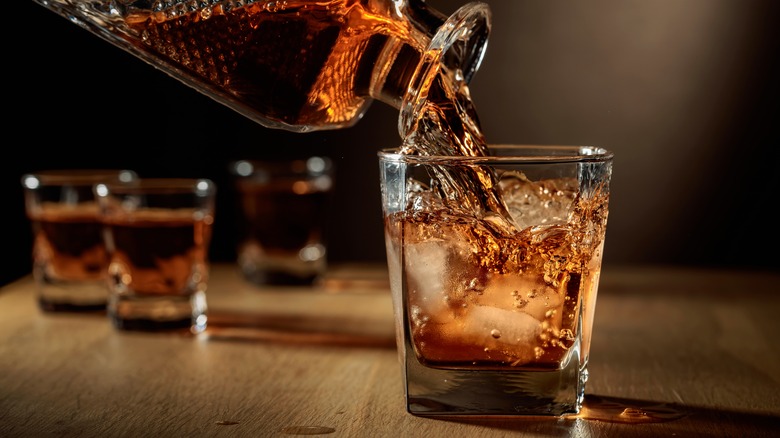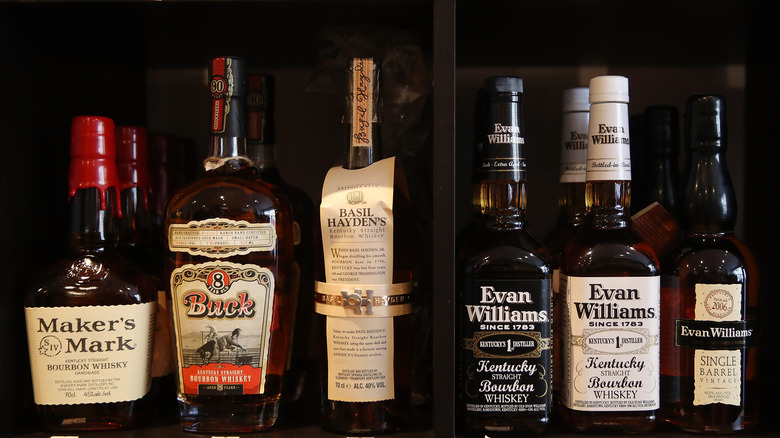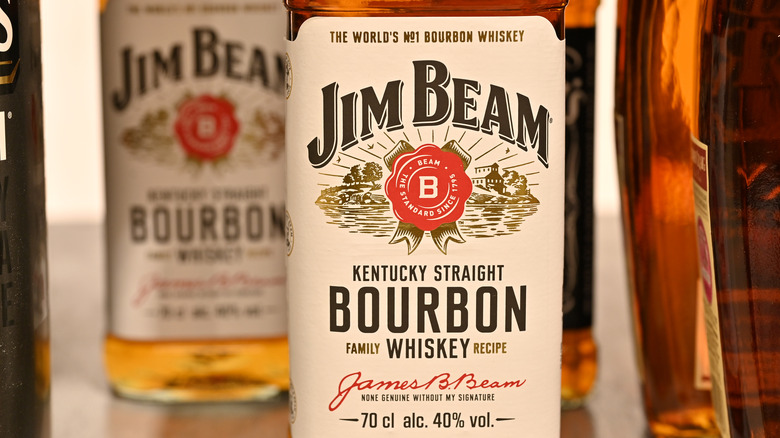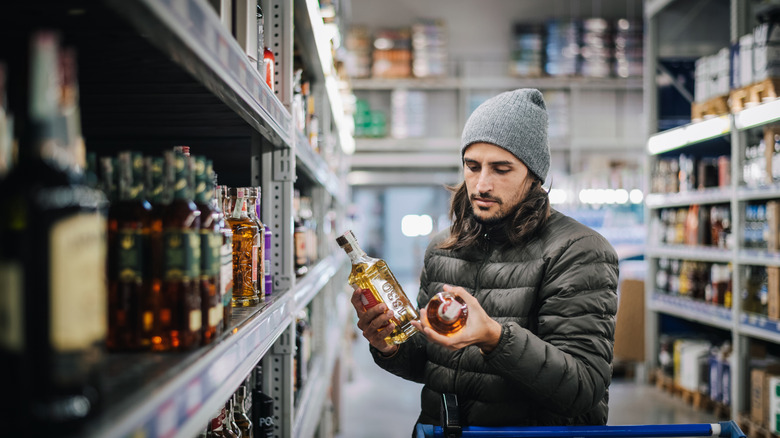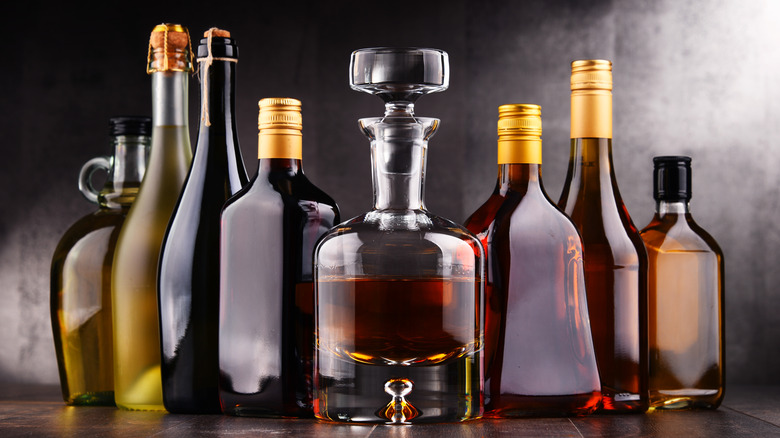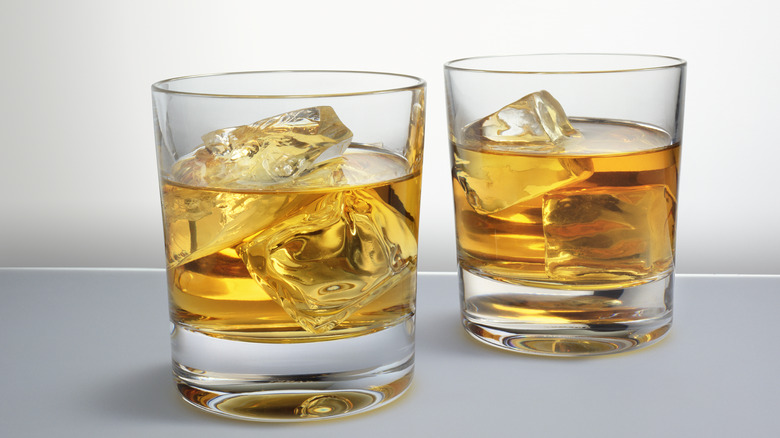How To Tell The Difference Between Real And Fake Bourbon, According To An Expert
Bourbon is big business and not just the multi-billion global market that exists for retail sales. No, there is also a thriving post-retail market where aficionados and investors buy and sell rare and sought-after bottles. Alas, whenever there is a fairly unregulated market such as this one, there are those who toss ethics out the door in service of the almighty dollar. That has led to reports of customers being duped by dubious merchants with bottles of bourbon that are not what they appear to be, as was the case with a large number of counterfeit bottles of Blanton's in 2021. Tasting Table reached out to Chris Blatner, Executive Bourbon Steward, Founder of Urban Bourbonist, LLC, and Executive Director of Bourbon Charity to find out more about the phenomenon and what consumers can do to ensure they don't fall victim to phony bourbons.
"It is going to be very difficult for most people to detect a fake bottle of bourbon these days, especially with the technology and sophisticated methods that scammers use," Blatner explains. "The absolute number one thing to do when purchasing an ultra-expensive bottle of bourbon is to only do it from a licensed and reputable retailer or auction house with a return policy." He also encourages buyers to know what the return policy is before they make a purchase.
Seal of approval
Blatner is no fan of social media — even if it did play a huge role in one bourbon's popularity — when it comes to the secondary bourbon market, he tells Tasting Table. The likelihood of being scammed by sellers on social media and other dodgy websites far outweighs the chance of getting what you've actually paid for. But Blatner understands that some people like the thrill of the chase and may feel drawn to buying a special bottle this way. If that's the case, he offers a few tips for spotting fakes.
First, he says, look for seals or tax stamps that cover the cork of the bottle that are missing or look like they've been tampered with. Bottles of bourbon — and all other spirits — were once issued tax stamps by the U.S. Treasury Department. These indicated that the proper taxes had been paid on the bottle by the distiller and were wrapped over the cork or cap of the bottle. Though no longer in use, some distilleries still place a similar type of seal over the cork of the bottle. Scammers will attempt to fill bottles with subpar bourbon or other spirits and in so doing destroy the seal. Make sure that these are in place before buying a rare vintage. "Look for major rips or tears in the seal or tax stamp," says Blatner. "If there are any, do not buy.
Know your bottle
Bourbon labels are works of art. From the shape of the glass to the label art, this is no small part of the allure for collectors. The labels also hold a wealth of information about the bourbon inside and the distillery in general. In many cases, they echo the history of the brand. That's why Blatner advises knowing and carefully studying the label on the bottle before making any major purchase.
"Carefully inspect labels and look for obvious misspellings or mismatched fonts," notes Blatner. "Make sure labels are applied and lined up correctly without folds or misalignment. Also, have a good understanding of what you are buying before you actually make a purchase. Where was the whiskey made? Check the label to make sure it matches." Buyers should also take note of the DSP (distilled spirits plant) and check the label to see if it matches. "If the label has batch numbers and bottling dates, confirm that those are actual batches and dates of bottling with the distillery," he adds.
The price is right
If you're on the hunt for rare bourbon, it is more than likely you know that you're going to be paying a steep price. That doesn't mean, though, that you don't love a great value, so when one comes along it can be tempting to chase it. But, Blatner cautions against chasing savings that seem unreal. While there are folks who don't know the value of what they're selling, by-and-large the secondary whiskey market is made up of well-informed agents who follow the market for individual bottles and price accordingly. And, that is exactly what he says you should do too.
"Know the estimated value of the bottle you are looking to purchase," Blatner says. "Check sites like Bottle Blue Book for reference. If the price is too good to be true... then it's very likely a fake." Scammers prey on the gullibility and desire for a deal that many neophyte bourbon collectors bring with them to the marketplace. While you may miss a deal, you'll also dodge a plethora of fake bourbons by being able to discern the correct price.
Bottled up
Remember how important the label is in helping you avoid a rip-off? Well, what is wrapped around can be just as useful. Bourbon bottles are almost always unique to each brand. Some are stout, others are long. Some have squared-off edges while a great many are round. Blatner says you should know everything about the bottle shape before laying down the cash. "Know what the bottle is supposed to look like," he explains. "Almost all brands have consistency in bottling of their product using the same bottle shape and type over and over again. If the bottle you are buying does not match what the brand typically uses, it's likely a fake."
When you know what you're looking for, go online, head to a liquor store, or both. Search for images of the bottle so you can have ironclad evidence of the factors that make up the bottle. What color glass is used? Is the neck long or short? Does it taper to the body of the bottle or does it abruptly widen?
Be authentic
When you get a purebred dog, you get the papers. Now, there's a mountain of difference between a dog and a bottle of bourbon, but the same rule applies. Blatner says any seller worth their salt will be able to provide the buyer with some sort of documentation that proves the bourbon is what they purport it to be. That documentation will also likely show the chain of possession, further assuring those suspicious that the bourbon in hand comes from where it is supposed to. "Ask for authentication," he urges. "If buying from a licensed retailer they should be able to provide proof of their purchase from a distributor. If buying from an auction house they should be able to provide documentation of how they authenticated the bottle."
If the seller hesitates at a request such as this, it is time to walk away. This outlines Blatner's overarching point, which is that the best defense is to be an informed and proactive buyer. Scammers would rather make the sale and move on quickly. By engaging them, asking questions, inspecting the product, and requesting documentation, you can generally suss them out or cause them to pull out of the scam. While they'll probably say they're taking the deal elsewhere, rest assured knowing that you probably didn't get swindled
